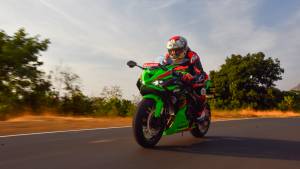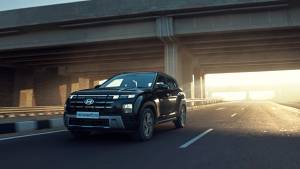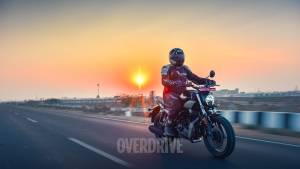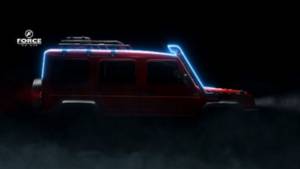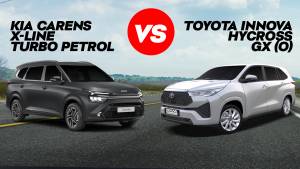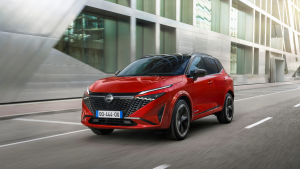Interview with Chetan Shedjale, senior motorcycle designer at Harley-Davidson
Chetan Shedjale is senior motorcycle designer at Harley-Davidson. Born in Sholapur, Shedjale had a major role to play in the Street 750. Shedjale has considerable design experience, including working with Massimo Tamburini at Cagiva.
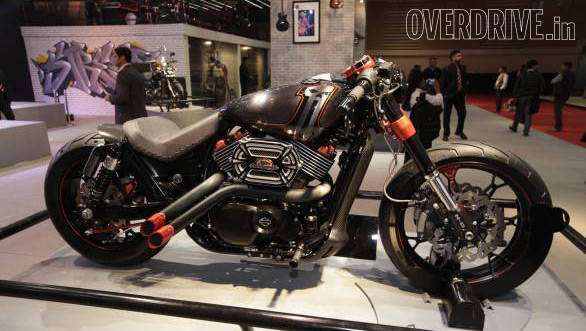 Harley-Davidson Urban Street 750 Custom
Harley-Davidson Urban Street 750 Custom
Shumi: Your thesis project was a design centre for a two-wheeler manufacturer and now you worked at a two-wheeler design centre. What did you put in your thesis that you now know was a bad idea? What was in your thesis that was a fantastic idea that Harley-Davidson should still do?
Chetan: In those days, when I did a thesis, it was more like a student project. I didn't know what a clay area was, but I had heard of it. So you are just drawing a block of space, but actually the way the system is, with lifts and all the stuff for clay, it's very, very different and I didn't know that. Nobody would ever allow you to go there, to that last end. Obviously, in those days, Hero, for instance, was a small (player, then), so it was doing it in clay, at a small scale, but it's all jugaad-panti. And compared to Harley, where you have five lifts and all of them are always full and people are working all the time, so it's very different.
Shumi: The problem of access to designers is a constant problem. If I was doing project like this, a two-wheeler manufacturer would not give me access to its designers even if it was to understand the structure in which they work.
Chetan: See there are certain zones which are highly confidential. Even in our building, for example, Mohnish [Nagrani, Harley India's communications whiz] is an India office employee, but he's only allowed up till a certain limit. If he has to be inside, we will bring him in, otherwise it stops at 'thank you very much for your input, we will talk with you later'. And it's a very tight community. Like we are only six designers, Frank [Savage, lead designer on Street; manager Industrial Design at H-D] 750 is one of the managers, there are two other managers, a couple of others in administration - those are the ones who have a look at it every day, but the rest of the world, only once in a while. Even all the engineers - 500 of them working with me and they have to ask for permission from me to come inside. That's very natural.
Shumi: So we were at the part where you had finished your internship and you had gone back to architecture school, figured out what you wanted to do. . .
Chetan: By the time I had completed my thesis I had figured out that this is the field I would like to work in - that's transportation design. I didn't know it would be motorcycles, but I had a feeling about. Ideas kept on projecting in my mind - that I'd like to make a scooter of such and such kind and would start finding small things to start it, like a junkyard scooter thrown away. I would start talking to my dad. He is kind of the backbone of my whole career path and somewhere, he felt he couldn't do certain things because all of us are from an artistic family. He couldn't pursue it because of financial reasons. See it's simple. When you're from middle class family, you can't realise those big dreams very easily. . . by the time, we figured out that I was going to do this (transportation design), that was always in discussion. And I took the NID (National Institute of Design) entrance exams. From the first preliminary exam held all over India to the next 25 to 30 levels which take you to Ahmadabad where they have a workshop - everywhere I started excelling. All the other guys were still struggling wondering 'why are they asking me to do this,' but I would say 'I'm happy to do this.'
And then the results came out - I was among the top ten guys. We were admitted to the master's programme in Product Design. At that point, I felt that if I was standing among these guys at that level, there was a chance that I could figure out a way to pursue transport design. Because it was an industrial design product.
So the hunt started and in those days, Internet was so costly - an hour was Rs 50 and the speed was nothing. So you were struggling to get those addresses, correct email IDs - you had to learn communication style of basic normal things. So it brought me up again.
I got an admission offer letter from Conventry and Scuola Politecnica di Design, Milan. The finances came in again. My dad had to give up his life savings and it was a risk because we are an Indian society. Here it's very different. People criticise you. Everyone was coming up to my dad and saying ' what are you doing?', 'your son is crazy,' etc etc.
But my dad told me, "You want to go? You go. . ."
So Milan was a better option in terms of finances and the master's programme was for a year and I decided to go ahead and go it.
When I went there, I found out that the whole education programme was in Italian. . . It was a totally new country. It was the first flight of my life - everything was a first. I arrived with 50kg of luggage and a sack on my back with dollars in it. Well, this lady who's now a good friend of mine, used to be the admin and she said, "Don't worry, you will settle down. It takes time."
I think in three months, I had started using Italian words - the easy ones. By the end of the year, I would be presenting myself in Italian to Giugiaro. School was so big, they'd started bringing people - all the big industry guys and it was fun because you're meeting Lorenzo Ramaciotti and Pininfarina's son. So you are in this whole design arena. We were like 15 students in one class and each of us was battling for that first job, which was the biggest task.
Fortunately and unfortunately, but I guess it was a good thing, I came in contact with Salvatore Cacciatore. He's not with Fiat anymore. He and Roberto Giolito, the guy responsible for the Fiat 500 project, they both saw my sketching skills etc and they said, "We will hire you but we can't pay you."
And my dad said, "We've risked so much this far we can do the same for a little more time."
Fiat was good experience. I was with 25 different students from all over the world who had come for an internship. So again, you're battling for your place and your survival and existence because (even though) I was bringing Indian culture, I was Europeanised already. The competition is hard. And I was in cars, but I wanted to do motorcycles.
Shumi: I agree with you. . . cars are no fun
This summer, I'm not going anywhere for vacation and I'm going to ask one of my friends to help us out."
So these two guy's - John Salavini and Filippo Corticelli (who used to be the Yamaha scooter division manager for the Milan studio) they both literally whacked me [into shape]. I was really bad at certain things. So at time's they'd just take my hand, for instance, and teach me how to draw an ellipse. They taught me and made me ready for the market. My portfolio was ready in 90 days, which was the best work I'd done for me at that moment. I would cry to myself thinking 'what I used to do and what I am doing is way different.'
They also helped me with addresses and connections to companies in Italy and around the globe. Filippo wrote a couple of emails to many other people whom he knew, saying 'this guy is good but you guys decide.' That was my turning point.
I was at Fiat talking to a couple of guys when my phone rang and a lady who spoke a mix of English and Italian said, "I would like to talk with Chetan?"
And I said, "Speaking." And she said, "Would you like to meet Massimo Tamburini? I'm calling from his office and it's based in San Marino." And I said, "Yes, I can." because I knew who he was. I knew what he is for the industry.
Then, the following Thursday I went to meet him. It was a turning point for my life because he saw my work and he didn't say anything except for two words in Italian (because he never spoke English and he tried to stay away from journalist who only spoke only in English), "Lavorare con me (Would you like to work with me?)"
Someone like him, a god, was asking me to work with him.
I said, "Yes."And he asked how much I was getting paid in Fiat. I said, "I am working for free."
He said, "That's wrong. You're skilled. You need to get paid."
And I said, "Okay!"
And in three months, I signed up with CRC and I started working. For 5 years, I worked with him. He retired and I moved away from CRC. It was cause of a financial crisis. CRC had started shrinking. That's where the next struggle part came in.
You know a lot of people in the industry, you speak different languages fluently, you have connections and roots in this country which is booming. So I started looking at connections where I could not only be hired as a designer but also receive a little bit of respect, because I already had worked with someone, who is respected.
So Raffaele Zaccagnini, used to be the director of design at Husqvarna, which used to be run by BMW. He said, "We want to hire you but it's a very small project and we want you to be there as a manager and run the show for this whole thing." It was a pilot thing which later on was known to as the Husqvarna Terra and Strada 650. So that was my project when I started. I kind of led it through its initial design phase to a clay mock up. And then by the time I was working with them, Harley called me and said they'd sent me an email. The email just said, "Why don't you call me?" So I called him back and he said, "We want to meet you. Would you like to come to Milwaukee?"
So again it was a turning point. I was on my first flight to USA. I went there and it was a risk again because I already had a job which was going just fine. Again my father comes in the discussion and says, "Go. Let's see what happens."
Well, the first thing that happens there is I'm sitting in the studio, presenting myself. Frank and the other guys are sitting there was this one chair that was vacant. And in comes the old man, Willie G Davidson, and he sits beside me, looks at a couple of my sketches and says, "I don't know what these guys are thinking, but I think you should work with us." And he walks away.
This was the same thing that happened with me with Tamburini. He is the father of my career. The day he had passed away, I was so shocked that the whole day I couldn't even talk. That's how connected I was with him. By the end of his career he took retirement and the same thing happened with Willie.
I still adore him (Willie). He's incredible. Every time we met, we discussed not only motorcycles, but everything.
So that day, he'd just said that while walking away and Ray [Drea, chief stylist at Harley-Davidson] said, "Well, the big guy has spoken, so what do you think?" Then there were some issues related to contract and logistical things, so we sorted those out and then they showed me the project. That was the Street. So that's why I call it my child. They said, "This is why we wanted to hire you. You can speak Italian. You can walk around India and you know the suppliers very well. This is a big project for us. The company is banking big on this, so we want your support."And they hired me as a contract guy so I had to fly every few days - 15 days I was in India, 15 days I was in Italy and 15 days in Milwaukee. And sometimes, the supplier was in South Korea, so I was there. It was fun and challenging and it turned into a whole lot of things so now it has five years (with Harley-Davidson). Four years as an employee, one year as a contract guy.
I think the proud part is being part of a company which is 111 years old. Can you imagine how big that is? Because when you carry that Bar and Shield on you, you are very much responsible for everything . . .
Shumi: So what are you working on right now?
Chetan: I can't tell you that
Chetan: There is a very simple formula over there. There are tradeoffs and that's what happened with the Street. As always, the designer will think out of the box. Then we bring it down to where it can be a production bike. In the mean time, we were dealing with different issues also. We had to keep the customers in mind, those who wants to buy a Harley but also don't want to spend. They want it to be within their reach, to be inside the brand. So it was one of the important things to keep in mind while taking certain discussions. But we have been progressing in different ways and the customer has been king. So we do take feedback.
Shumi: If you go back to the CRC days - I think you were there at the time when they were at their best. They had the budget. They had the intention. They were doing some of the best work in the industry at that time. How was that experience in that kind of a design environment and how is the Italian environment different from the American one you worked in?
Chetan: The Italian environment was a family run thing. So Massimo was the guy who would decide whether the day is good or not. You are under tremendous pressure to impress him and you are doing your work, but in the end, he has the magic stick in his hand. He would say what would be going up. Or even something as simple as presenting stuff to Castiglioni - he would point at the sketches that needed to get refined and were to be going up. It was very different from Harley.
Shumi: How was the working relationship between Castiglioni and Tamburini?
Chetan: Back then, they were very close friends. Castiglioni would literally believe what Tamburini had to say and the relationship was strong because, if you see the 916 era or before, there was success behind all of them. . . Let's not talk in terms of sales here. Castiglioni was a very passionate guy and he was passionate about motorcycles. And he met with Tamburini, who was a fortune he had the skills to make the right machines. So they both together got along very well.
Shumi: Similarly, how was the relationship between Willie G, the design team and the engineering? You guys work in a field where commercial success is more vital to a project than it would be to the Italians they think about business last.
Chetan: Here we are dealing in a totally different environment. We have big design critiques. So Willie, he has his views and his vote, but there are other designers from different backgrounds. For example you have seen the video? Dais [Nagao, senior motorcycle designer at Harley-Davidson], he comes from Japan and he has spent his first 10 to 11 years in the West Coast in the US, so he brings the West Coast culture style to Harley. So his views are considered more important than just agreeing with the big guy. So it's more like a company view. We are more worried about the brand than our egos. You have to keep your personal love affair with one sketch outside before getting into the studio or even just across the walls. Because it's very important for us to make it successfully available for the customer, because the customer is the one who says 'aye' or 'nay.' Because no matter how much I like it, it's not going to matter. . . so it's very important for us to think in that way based on what the end user is going to say and how happy he's going to be with it because we are going to bring him inside the brand with that particular product.
Maybe, there are people who just buy (a bike) because of the colour and Harley is one of the biggest in the market with (a huge) colour palette. If you consider the North American market, there are guys who want to buy a CVO every year. And every year they change it, so we have to think of these guys also. So here, in this design environment, all of us have to work together. So it's very different from Italy. In Italy, you're working and working and you don't know when it will culminate into something. . .
Shumi: What do you think Indians are going to say about Project Livewire? What do you think their already saying about it? You guys have been showing the bike around the United States for about five months now?
Chetan: Very honestly, I haven't read the blogs, but obviously the core-guy will not like it and we were ready for that. We were looking for different feedbacks. It's just very interesting to see how they look at the brand and also as a futuristic idea considering environmental considerations and stuff. We wanted to see how people react and I think there have been positive responses. People like the jet engine sound. I rode it myself and it's a fantastic bike. We too were also skeptical sometimes, regarding how it would turn out and that's natural. But it's a really fantastic bike and I saw a couple of people riding it on the track.
Shumi: Do you think the brand is big enough to accommodate a non-cruiser, non-traditional powertrain?
Chetan: I think we did it. . .
Shumi: No. . . until it becomes production, you haven't done it. You're still working on it. Do you think that is the point of Project Livewire, to be able to explore. Because the core group is so strong in your brand, unlike any other brand.
Chetan: Well the core group is strong and it will continue to be. They are our customers and they are loyal to the brand and we have to take care of them. We also wanted to explore new ventures, to see how the world reacts to the Bar and Shield company coming up with new ideas.
Shumi: Let's talk about the customs that are to the Auto Expo. I'm not going to talk about the RDX but the Urban Custom, I really loved that as soon as I saw it. If I had a Street 750, that's what it would end up as. Tell me of the influences that led to that motorcycle?
Chetan: The Urban Custom is very simple. I think it was in December before I did the sketch. I was in India and I was in an autorickshaw in Bangalore from the airport or somewhere. So this guy, I think he had an Enfield - it's very, very vague memory. Anyway, I couldn't even take a picture of that guy riding, he went very fast. But that whole lifestyle that he showed, that clicked. He has this Ray Ban aviator glasses, half-faced helmet, a nice bag and he's riding a bike and it's chopped off like a typical customisation and some hazy colour it looked like. And then when I went back to USA, it just stayed with me. If you know Harley-Davidson and the Marlboro Man (1991) - that image clicked with me and I was talking to Frank and he said that 'maybe you are talking of this bike or something like this'. Well, this is what happens inside the design studios, you know. . .you start. . .
Shumi: . . . discussing movies?
Chetan:
So I think I did the RDX first - it had been in talks already and the Urban Custom was just a blue sketch which I had done. And then Frank said, "That is something we should refine more."
So I did that and we had a pool of designers who were competing. The leadership fortunately picked my Urban Custom so I had two bikes in the show of which the first bike was again, my bike, the Street.
So the Urban Custom was born and then its conceptualisation and the rest of the stuff you have seen in the videos. It also shows off a little bit of Europeanisation, my connection with sportsbikes, even used of parts or even colour combinations.
So it was more like I brought in some Europeanisation with me and I put it through my flow for the custom bikes with regard to how I was going to match those. That's natural amalgamation of different influences - born in India, brought up half the way in Europe as a designer, and then you fly to the US so you're giving them a taste of this spice which is different. When it all came together, people just said 'this is something which is different and nice and we should present it.' So the leadership was happy and well, you've seen the bike.
Shumi: So now, the RDX is a café racer, the Urban custom is sort of subscribing to that style. They're very cool right now so do you think the XLCR will come back?
Chetan: I don't know. It's not been considered.
Shumi: It's not even on your radar?
Chetan: For a future product . . . I can't talk about that.
Shumi: If you go back to history, what would be your favourite Harley-Davidson?
Chetan: If feel like I'm more into those big touring bikes. You know what Harley-Davidson was for me while I was growing up? Lots of flashy chrome and big touring bikes, which were in the Soft Tail era or when the bikes were slowly going towards that FXR, which was a very strange faring but it still holds the market right now. It's very different. People are chopping it, making so many - if you roam on the West Coast, you will see that very different things are happening on that particular bike. Those are the bikes whose power train should be an Evo or a Knucklehead, not even a Panhead but more Knucklehead. I feel like they are they are the ones that really shaped the design history of Harley.
Shumi: Are there any motorcycles outside the Harley-Davidson family that you think have influenced the Harley-Davidsons?
Chetan: See we have been the pioneers in many ways so I wouldn't say some other brand has influenced Harley.
Shumi: Not in terms of a brand, but a specific motorcycle. Somebody tried something on a motorcycle that everybody thought, 'Hey, that's a good idea we should work it out.'
Chetan: Sometimes it happens. But it's not like we take that and make it happen. There are different things - I don't have a specific answer for you on that but you do have those influences. That's why I'm visiting India Bike Week, to see what the crowd is interested in.
We visit every year, that's our home ground. Daytona Bike Week, North American Bike Week -we obviously cover everything, on rotation. And Moon Eyes is a one day show in Japan and you'll see a lot of really nice custom bikes. They do give us some sort of inspiration. For instance, 'I like that brass, the way he has done it' or 'Oh, I like that chrome, but he has done it in this way,' - Those are the things. It's not like it's totally form to form. There are very subtle things. For instance, tomorrow I may see a bike and I might just take after the wheel or just a bolt. That's how we pick those details and then we share.
Even websites like Bikeexif - they have the same trend, they show small details - those are very important. Because Harley is not just about big bikes, it's more about the small details and emotional connections. There are people who buy the bikes because of emotions connected with them thinking 'this is the one which I want to ride around'.
Shumi: Do you think there are any motorcycle customers in the world that do not buy a bike out of emotions? I think they all do. Completely unlike the car guys who can buy without emotions entirely?
Chetan: I think it is one of the reasons I moved from cars. I think I would have been sitting in a design studio, drawing wheels all my life. I didn't want to do that.
Shumi: Is car design more prestigious in the industry than bike design or there's no such thing? Chetan: No. I don't see that. I knew Massimo, he would ride at that age also. It was a prestigious thing. Also because he had designed it. I have seen David Rob, the guy who brought these BMW bikes. He did the same thing.
Shumi: You've been to Husqvarna. What do you think of the Vitpilen and the Svartpilen?
Chetan: They are done by Kiska now. I used to work for a small, different team,
Shumi: They're also going for a massive change in design strategy. Do you think the new designs work for them? Tell me what you like about that.
Chetan: There are new bikes and new trends so they're trying to show new things. That's a good part.
Shumi: But you've been there before. Do you think this is a direction you would have chosen for them if you had the option?
Chetan: Well it was way different, when I was working with them, because Rafaele had his own rules and stuff, so he had his own line of considerations construction. He would often come up and say 'the line of this has to be this and that.' Now it's literally a 180 degree change in direction.
Shumi: And the Nuda was done during your time?
Chetan: I think they have a done all the new stuff in the last one and half years. My term with Husqvarna was very short. . . I've been with Harley for the last five years.
Shumi: So what's next in terms of professional challenges? You've already done what is going to be the most successful Harley-Davidson probably in their history?
Chetan: I don't see it in that way. I do feel like it's something to be proud of. I'd like to stay with this brand. They've been humble. This is the brand that brought me some recognition. This is the brand where I have been happy. When I show up in their studio, I'm not as stressed as I used to be at MV. So it's something, which is very important for me because even I ended up working on Saturdays and a Sunday and Frank knows me. So I'll send him a message saying 'I'm in the studio' and they'll come in.
Shumi: You're taking them away from their families on a Saturday?
Chetan: Well it's way different for us we designers are like that. We all have these ideas that click in our minds late in the night and we have to finish it or else we forget it. And then you'll never get it back. That's the whole idea, so it's better to go and spend that half an hour or one hour and send it back and forth and finish it.
Starts Rs 1,02,700
149cc
5-Speed
12.40
13.60
-NA-
